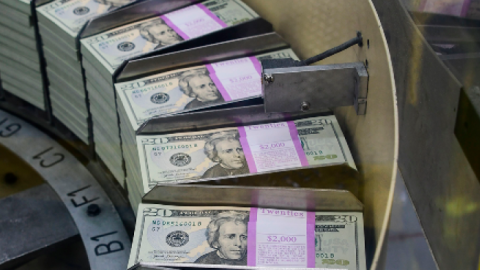Who has heard of the monetary repression tax (MRT)?
Very few, it seems, judging by the lack of popular anger. Yet revenues from this tax have swollen under the 2 percent inflation standard. They are now set to reach a new record level as the pandemic recedes, with guesstimates for the US alone this year around $600 billion.
There is nothing new in a fiat money central bank imposing an effective tax on the public’s holdings of government bonds and bills (including those in the banking system) by manipulating interest rates to artificially low levels, especially in real terms. Until the twenty-first century, however, no one thought this could continue for long without triggering some combination of accelerating consumer price inflation and a nonsustainable, highly speculative economic boom.
We have learnt in the long cyclical expansion which started in 2009 (later in Europe), interrupted recently by a pandemic spasm, that virulent monetary inflation (of which a key driver is interest rate manipulation) can coexist with “lowflation,” a persistent absence of economic boom and a continuous powerful asset inflation. Indeed, the high speculative temperatures in asset markets, far from triggering any monetary response, facilitate the vast collection of MRT. Many individuals are convinced that they can avoid MRT by using their skills to make persistent capital gains across a wide range of assets.
Toward understanding MRT, let’s take a step back to, first, some definitions and, second, a setting of historical context.
Cumulative collections of monetary repression tax correspond to the amount by which interest income in real terms from safe assets (in nominal terms) like government paper is below what it would be under a sound money regime.
We should distinguish MRT from the better-known inflation tax. MRT includes first the windfall loss in real terms which holders of government bonds suffer from an unexpected surge in consumer price inflation and, second, the erosion in real value of non-interest-bearing high-powered money (today mainly banknotes) as caused by continuous inflation.
As far back as the Roaring Twenties we can identify an embryo of the potential for the levying of MRT. The presence of powerful nonmonetary forces of disinflation—rapid productivity growth stemming from the Second Industrial Revolution plus commodity glut—meant that the Fed could manipulate rates downward in pursuance of stable prices (as against an episode of falling prices, which would have occurred under a sound money regime). But emergence of a colossal speculative economic boom in the US and, most of all, the Weimar Republic (essentially part of the dollar zone from 1924) meant there could be no steady state of asset inflation and stable consumer prices. In any case, with federal government debt then below 30 percent of GDP, the US government had no interest in collecting MRT. Herbert Hoover (elected president in November 1928) was a vocal critic of speculative frenzy on Wall Street and of how the Federal Reserve under Benjamin Strong had stimulated this.
Fast-forward to the early 2000s. Already from 1997 onward, the Fed had started the process of joining the 2 percent inflation standard, at a time of rapid productivity growth related to the IT revolution that fueled asset inflation. Amid the contemporary federal government budget surpluses, there was no thought of monetary taxation. Briefly in 2000, the Fed ceased its rate manipulations in response to a small late spurt of consumer prices above target.
Then, in the aftermath of a very mild recession (since revised away by the statisticians), the Bush administration pressed ahead with huge unfunded tax cuts. The Fed, with its newly appointed star from Princeton as governor and its chair seeking a new term extension, obliged by manipulating rates downward. MRT was born in 2002–04 amid powerful asset inflation. Even despite powerful nonmonetary forces of disinflation including globalization and digitalization, consumer price inflation rose above target in 2005–06 against the background of a growingly speculative global economic boom, triggering a sharp tightening of monetary policy. Accordingly, MRT collection was aborted in the run-up to the crash and Great Recession.
It has been quite different in the long economic expansion since 2010. Massive fiscal deficits in the US, Europe, and Japan have had a counterpart in the levying of a giant monetary repression tax. Goods and services inflation did not gallop ahead again. No heady economic boom developed. Asset inflation became virulent. US president Donald Trump and Japan prime minister Shinzo Abe followed a political strategy of seeking to camouflage massive collections of MRT (especially in the US, following the big business tax cuts) by exciting popular excitement about gains in the stock market, for which they claimed credit.
The failure of consumer price inflation to accelerate despite the waning of productivity growth since the late 1990s and early 2000s—hardly surprising among growing malinvestment—is remarkable. Explanations for this failure—in fact closely related to the nonarrival of tremendous economic boom despite the manipulated interest rates—include, prominently, sclerosis of the economic system deriving from the monetary inflation.
Some households clobbered by high MRT and not under the spell of asset market gains forever boosted their savings for retirement. Investors in equities did not in general reward business for making long-gestation investments given presentiments about an eventual day of reckoning but instead chased momentum and especially the wonders of financial engineering. This meant that official and market perceptions of the so-called neutral rate of interest fell far below where they would have been under sound money.
A further factor operates in the same direction of sclerosis—the growth of monopoly power itself fueled by the asset inflation. The speculative story about a company gaining present or future monopoly power has proved to be a winner (in terms of sending particular equity values to the sky) for investors starved of interest income. The monopoly story has been a key component of the market craze about digitalization, whose features of winner take all and network effects have had great speculative appeal. The would-be monopolist gaining from an especially low cost of equity capital can eradicate competitive threats from new entrants by some combination of price cutting and preemptive takeover. The resulting loss of economic dynamism shows up in a fall of the apparent neutral interest rate.
Hence low or negative rates have not fed higher consumer price inflation and meanwhile asset inflation shows no endogenous tendency to go into reverse as might happen through falling profits rates or growing credit defaults and encounters no political resistance. In fact, we have been in a situation now for many years where high monetary repression tax co-exists with stable low consumer price inflation and persistent asset inflation. (The measure here for asset inflation is the overall degree to which price signals in capital markets are corrupted by monetary inflation).
It is plausible that the pandemic has extended the life of this stationary state for consumer price inflation and asset inflation. Whatever the buzz in the financial media, the pandemic has subtracted from economic prosperity. Absent the optical illusion of fantastic quarterly growth rates, even where an economy (such as the US) is now back to the same GDP level as on the eve of the pandemic, there has been a big loss of cumulative income along the way. Moreover, GDP during the pandemic and even now includes much expenditure related to the war against covid—not normally regarded as a component of prosperity.
Stepped-up monetary inflation and vast issuance of government debt to finance relief payments plus other transfers could mean that individuals in aggregate across the advanced economies feel better off. If so, that is a delusion founded on disregard of the vast MRT now being paid and of other tax burdens which will surely become heavier.
These fundamentals are a headwind for private spending. We should add the potential decline ahead of business investment in the pandemic boom (or bubble?) sectors. Hence, the level of interest rates seemingly consistent with economic balance as the pandemic recedes could be lower than prepandemic. Governments and their central banks would have new scope to manipulate down rates without provoking an acceleration of consumer price inflation, collecting vast amounts of MRT under the cover of still popular asset inflation.
There are alternative scenarios, though, where the collection of MRT wanes and instead governments turn to the inflation tax. For example, suppose a further Fed “stimulus” in winter 2021/2022, implemented as a growth cycle downturn or worse emerged, failed to arrest the journey of asset inflation into asset market crash and recession. As the huge malinvestment of the past decade including the pandemic shows up as capital stock obsolescence, as government expenditure ratchets higher, and the Fed radicalizes further its conduct of monetary policy, the criers of wolf on high consumer price inflation could well prove correct.




















